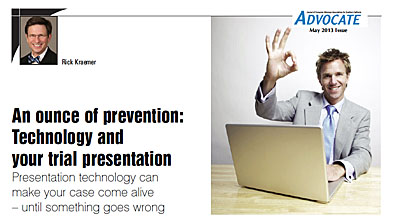
EP Congratulates: Shegerian & Associates
August 9, 2013Fourth In A Series: An Ounce Of Prevention — Video
August 20, 2013 With the Consumer Attorney’s Association of Los Angeles’ (CAALA) annual Las Vegas Convention arriving August 29, we’re serializing a feature article on trial presentation that appeared in the May 2013 issue of CAALA’s Advocate Magazine. Last week, Rick highlighted the some key issues regarding computer systems, components, and software. This week he goes to court with the technology and tactics that will put less error in your trial:
With the Consumer Attorney’s Association of Los Angeles’ (CAALA) annual Las Vegas Convention arriving August 29, we’re serializing a feature article on trial presentation that appeared in the May 2013 issue of CAALA’s Advocate Magazine. Last week, Rick highlighted the some key issues regarding computer systems, components, and software. This week he goes to court with the technology and tactics that will put less error in your trial:
Document intensive trials – for example, business cases – rely heavily on digital trial presentations. When dealing with thousands and thousands of documents, you can’t afford to be fumbling around trying to find a single paragraph amidst a sea of millions to prove your point. In order to reduce the likelihood of appearing disorganized when it matters most, prepare ahead of time by taking these preventive measures.
• Trial software packages such as Sanction II and Trial Director
Sanction II and Trial Director are easy to use, point and click systems. These interactive, real-time presentation programs will allow you to organize your documents, exhibits, video clips and/or animations and present them on command.
These software programs are a must-have when it comes to managing large databases of exhibits for rapid recall. The software allows you to call out and highlight text on-the-fly, focusing the judge and jury on important aspects of case documents or testimony. They also enable you to show two documents on the screen side-by-side, for comparing and contrasting purposes.
• Practice, practice, practice
The best software in the world will not add anything to your case if you don’t know how to use it properly. The longer you make a jury wait while you sort out a program, the less credible you appear. If your budget does not allow for you to hire a professional trial technician to operate the technology for you in court, make an appointment with one well before trial starts for training on how to use the software properly, and then make the time to practice. Run through using the technology while you are speaking; and remember to maintain eye contact and a connection with the jurors.If you’re presenting more than a basic database of black and white documents, we highly recommend that you hire a professional trial technician to build your database and assist you in court. And remember to spend time rehearsing how you will communicate with them during trial when you need them to call up an exhibit or transition to the next slide.
• Have a backup for everything
It is always better to be safe than sorry, and one of the easiest ways you can prevent technology trouble in trial is to keep extra copies of your files and backup equipment, such as cables, projector bulbs, and other peripherals. Have a backup computer whenever possible. Finally, keep a hard copy of your visuals that can travel with you. If your computer fails during your PowerPoint presentation, you can place the hard copies on the Elmo.
• Scout out the scene
Determine the size and layout of the courtroom and what, if any, presentation equipment is already available in the courtroom. You’ll want to consider the age and quality of the courtroom’s equipment and make sure it is adequate for your needs. Courtrooms rarely have the most current technology, and you may want to put in a request to install some or all of your own equipment. And remember to confirm what presentation equipment the judge will permit in the courtroom.
You may have to call the court clerk to check on when you will be allowed to set up your equipment, often it isn’t allowed until after jury selection. Typically, there is a very limited window of time allotted for set up.
• Keep an eye on the time
Judges and juries don’t like to wait, so it’s important when maneuvering through your trial presentation database that you can easily and quickly segue from a document to a video to a photo without long pauses in between. Seconds will feel like a lifetime, so make sure video clips don’t include gaps of dead air. When using video clips to impeach witness testimony, the length of the clips matter – keep them short enough to hold everyone’s attention, but long enough so that they retain context and credibility.
Next week: Lights! Camera! Action!


